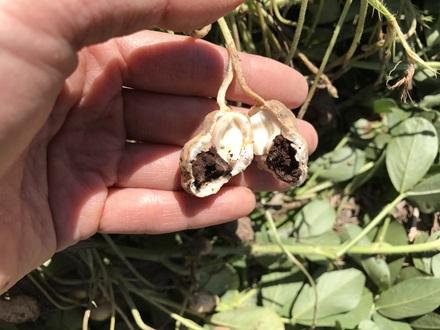ARS, Argentine Scientists Join to Fight Peanut Fungal Disease
Americans love their peanuts. We eat, on average, nearly 8 pounds of peanuts per year, not to mention all the peanut butter and other foods that contain peanuts. Peanuts are the seventh-most valuable crop in the country, worth $1.6 billion, and $890 million in exports.
With data like that, scientists with the Agricultural Research Service (ARS) are working hard to keep America’s peanuts safe, with projects ranging from increasing crop yield, to developing new products, to improving disease resistance.
Researchers at the ARS Peanut and Small Grains Research Unit (PSGRU) at Stillwater, OK, and Foreign Disease and Weed (FDWSRU) Research Unit at Ft. Detrick, MD, are looking to prevent a major plant disease from affecting America’s favorite nut – a fungal disease known as peanut smut (Thecaphora frezzii).
South America is currently the only place where peanut smut thrives; in Argentina, the fungal disease has infested every commercial field. Crop loss can be as high as 30 percent.

This peanut is misshapen and infected with peanut smut fungus. (Photo courtesy of Rebecca Bennett)
“Peanut smut can be a devastating disease in areas where it is present,” said Rachel Koch Bach, plant pathologist at FDWSRU. “Moreover, if it were to get into the soil in new areas, such as the United States, it would be extremely difficult to eradicate.”
ARS has teamed up with its Argentinian counterpart, the Instituto Nacional de Tecnología Agropecuaria (INTA), and the Foundation for the Study of Invasive Species in Argentina (an ARS overseas biological control laboratory). Their goal is to develop disease-resistant peanuts and to protect the American peanut industry.
According to Kelly Chamberlin, PSGRU supervisory plant biologist, the scientists at INTA help ARS identify germplasm from the U.S. peanut mini-core collection that is resistant to peanut smut.
These sources provide scientists with the resistant germplasm that they need to breed smut-resistant commercial peanut cultivars.
“This work will also help to reduce detrimental impacts should the peanut smut fungus arrive in the U.S.,” Koch Bach and Chamberlin said. “By working with INTA, we will soon have smut-resistant cultivars available for U.S. peanut farmers. We are also working on ways to detect the fungus through diagnostic assays.”
The research team has already achieved some successes, Koch Bach said, including identifying resistant germplasm, which will help growers and others in the peanut industry immediately. They’ve also had some successes on the pathogen side, too, by assembling the genome of the pathogen. This knowledge will help scientists learn about how the pathogen reproduces and how it changes as it spreads.
“It’s incredibly important that USDA wants scientists to work on crop diseases that are currently not present in the United States,” Koch Bach said. “With the interconnectedness of the world through trade and travel, plant pathogens can spread quickly across the globe and oftentimes go undetected for some time. By working on diseases before they are present in the U.S., we buy ourselves time to learn about the pathogen and determine what strategies work in eradicating it or lessening its effects.
“The quicker we can act using strategies that we know will be effective, the better off we are at safeguarding this nation’s agricultural economy,” she said.
Funding for this project is provided by MARS, Incorporated and the USDA Agricultural Research Service. – by Scott Elliott, ARS Office of Communications

